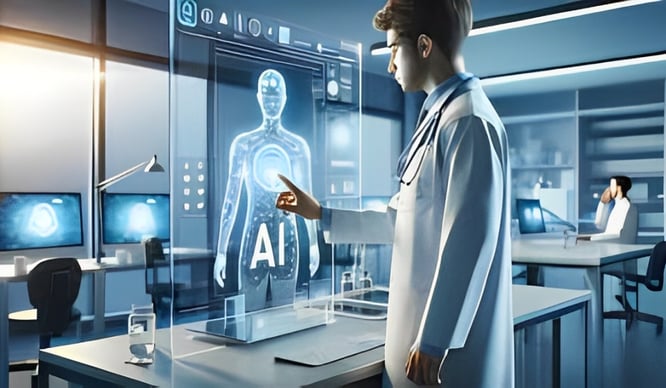AI-Enhanced X-Ray Technology: Reducing Human Error in Medical Imaging
In the world of healthcare, accurate diagnosis is paramount. For decades, X-ray imaging has been a cornerstone of medical diagnostics, allowing doctors to peer inside the human body without the need for invasive surgery. However, like any tool, X-ray imaging is not immune to errors. Human error in interpreting X-ray images can lead to misdiagnosis, delayed treatments, and unnecessary procedures, all of which can have serious consequences for patients. This is where AI-enhanced X-ray technology is stepping in, revolutionizing the way X-rays are interpreted and reducing the risk of human error.
2/27/20254 min read


The Challenges of Human Error in Traditional X-Ray Diagnosis
Human error in medical imaging can occur at various stages, from the actual taking of the X-ray to the interpretation of the image. Radiologists, who are trained to identify abnormalities such as fractures, tumors, infections, or other health issues, are still susceptible to mistakes. Some common reasons for human error include:
Fatigue and Workload: Radiologists often face large volumes of cases, leading to fatigue and the possibility of overlooking key details in X-ray images.
Misinterpretation: X-rays can sometimes be ambiguous, with subtle signs of disease that might be missed by even the most experienced radiologists.
Time Pressure: In busy healthcare environments, radiologists may feel pressure to read and interpret a high number of images within a limited timeframe, increasing the likelihood of errors.
Even minor misinterpretations can lead to incorrect diagnoses, delayed treatments, or unnecessary tests, all of which can negatively affect patient care.
How AI is Enhancing X-Ray Technology
Artificial Intelligence (AI) has emerged as a game-changer in the field of medical imaging. AI-powered tools are designed to assist radiologists in interpreting X-ray images with higher accuracy and efficiency. Here's how AI is improving X-ray technology and reducing human error:
1. Automating Image Analysis
One of the key benefits of AI in X-ray imaging is the ability to automate the analysis of X-ray images. AI algorithms, especially those based on machine learning and deep learning, are trained on vast datasets of medical images to identify patterns and anomalies. These algorithms can analyze X-rays far more quickly and accurately than humans in some cases, identifying even the most subtle signs of abnormalities that may otherwise go unnoticed.
For example, AI can automatically flag potential issues like fractures, tumors, or infections, alerting the radiologist to areas that need further investigation. This assists the radiologist in making quicker and more informed decisions.
2. Reducing Interpretation Errors
AI algorithms are designed to be objective, eliminating the possibility of human biases or fatigue from affecting the analysis. By providing a second opinion, AI reduces the chance of errors that might stem from human limitations. The deep learning models used in AI are continuously updated with new data, ensuring that the system stays current with the latest medical knowledge and imaging techniques.
In fact, AI has shown promise in areas like detecting early-stage cancer, which is often difficult for even the most experienced radiologists to spot. AI systems are able to analyze the smallest details in X-ray images, detecting tumors, microfractures, and other conditions at stages where they might be more treatable.
3. Speed and Efficiency
AI-powered X-ray systems can process images in seconds, reducing the time it takes to interpret results. This speed is especially crucial in emergency situations where time is of the essence. In hospitals or clinics with high patient volumes, AI can help radiologists manage their workload more efficiently by providing faster and more accurate results.
For example, in cases of trauma or acute conditions, where a rapid diagnosis is necessary, AI can instantly analyze X-rays and provide immediate suggestions. This speeds up the decision-making process, allowing for quicker interventions and better patient outcomes.
4. Continuous Learning and Improvement
One of the most powerful features of AI is its ability to learn and improve over time. With machine learning algorithms, AI systems become more proficient as they are exposed to more data. This allows the system to become more accurate at recognizing new patterns in X-ray images, making AI-based X-ray systems more reliable with every case they process.
For instance, AI systems can identify nuances in X-ray images that were not previously detected by human radiologists. As more X-rays are fed into the system, AI can refine its models to provide increasingly accurate readings and predictions.
5. Enhancing Radiologist Productivity
Rather than replacing radiologists, AI is designed to enhance their work. By automating routine tasks like identifying common fractures or infections, AI frees up radiologists to focus on more complex cases and provide a higher level of care. This symbiotic relationship between AI and healthcare professionals can lead to more efficient and accurate diagnoses, reducing the burden on radiologists while improving overall diagnostic accuracy.
Case Studies of AI Success in X-Ray Imaging
Breast Cancer Detection: AI has been particularly successful in assisting with mammography for early breast cancer detection. Studies have shown that AI algorithms can match or even outperform human radiologists in detecting early signs of breast cancer, providing a higher level of accuracy in readings.
Lung Cancer Detection: AI-enhanced X-ray technology has also shown promise in identifying lung cancer in its early stages. By analyzing chest X-rays, AI systems can spot abnormal growths and tissue changes that may indicate lung cancer, even when they are too small to be noticed by the human eye.
Fracture Detection: AI tools are increasingly used to detect bone fractures, especially in trauma cases. In emergency settings, AI can quickly analyze X-rays and identify fractures in complex areas like the spine or pelvis, reducing the time required for diagnosis.
The Future of AI in X-Ray Technology
The future of AI in X-ray technology looks promising, with ongoing research and development aimed at improving the capabilities of AI-powered imaging systems. As AI technology evolves, we can expect even greater advancements, such as:
AI in 3D Imaging: Moving beyond 2D X-ray images, AI is expected to be integrated into 3D imaging techniques like CT scans and MRI, providing even more detailed views of the body.
Real-Time Diagnostics: AI could soon be used to analyze X-rays in real-time, providing instant feedback to healthcare professionals during medical procedures or surgeries.
Personalized Medicine: AI could help tailor treatments based on the individual patient's X-ray results, enabling more personalized and targeted care.


Reference Website Link:
Nature – Artificial Intelligence in Radiology
National Institutes of Health (NIH) – AI in Healthcare
https://www.nih.gov/news-events/news-releases/ai-based-program-detects-eye-disease
American College of Radiology (ACR)
Radiological Society of North America (RSNA)
Innovative
Contact Us
Service
xraybazar.com
© 2024. All rights reserved.
Address- Rajasthan, India
Gmail Id- xraybazaroffcial.com
Important Links
